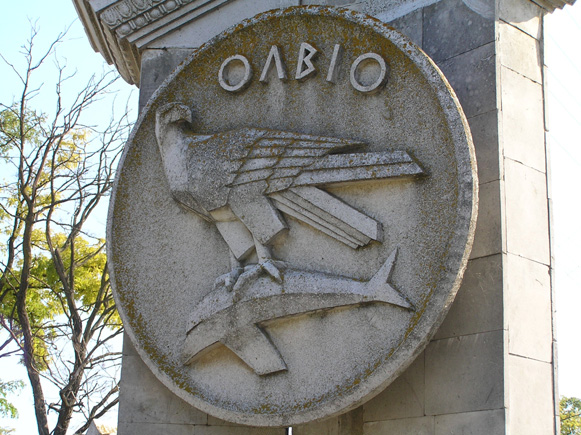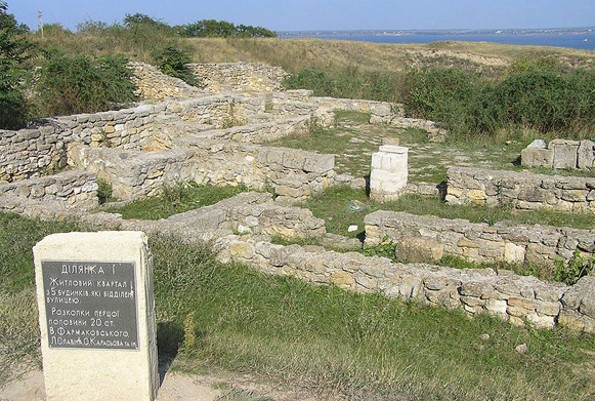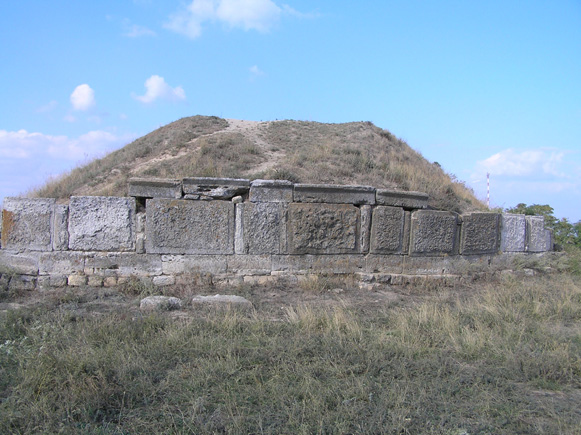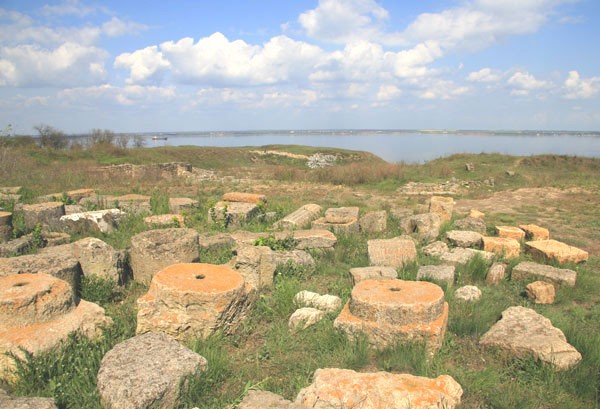Olbia National Historic and Archeological Reserve
Olbia National Historic and Archeological Reserve (Національний історико-археологічний заповідник ‘Ольвія’; Natsional'nyi istoryko-arkheolohichnyi zapovidnyk ‘Ol’viia’). A historic and archeological reserve under the auspices of the National Academy of Sciences of Ukraine. It was established in 1921 near the village of Parutyne, Ochakiv raion, Mykolaiv oblast, on the site of the ancient Pontic settlement of Olbia (see also Ancient states on the northern Black Sea coast). The site, which was discovered in the late 18th century, was placed under state protection only in 1924 as a ‘national heritage of the Ukrainian SSR.’ As a result, all artefacts discovered at the site had to remain in Ukrainian museums. In 1938 the reserve was placed under the auspices of the Academy of Sciences of the Ukrainian SSR upon the reorganization of its Institute of the History of Material Culture into the Institute of Archeology of the Academy of Sciences of the Ukrainian SSR. The reserve became the institute’s research department. In the 1940s, the institute organized a longstanding expedition devoted to the excavations of Pontic Olbia. In 1952 Olbia open-air museum located in the vicinity of Parutyne officially became a branch of the Institute of Archeology.
Since the 1970s on there have been continuous conservation and restoration works in the reserve, as well as preservation works aimed at protecting parts of the site, especially its coastal portion, from erosion from the Dnipro-Boh Estuary. Much of the reserve is an open-air museum with numerous artefacts requiring permanent preservation and/or restoration. A recent example of the successful restoration with the help of computer simulation is a retaining wall around a mound containing the burial vault of two local notables Eurisivius and Aretha dating from 2nd century AD. With an archeological expertise provided by Serhii Kryzhytsky, who headed the Olbia Archeological Expedition of the Institute of Archeology in 1972–94, the restoration was completed in 2006. The restored burial mound is among the most significant objects on display in the reserve today.
In 2002 the Olbia State Historic and Archeological Reserve was granted the status of a national institution and assumed its current name. It became an independent entity within the National Academy of Sciences of Ukraine, but its research activities are administered by the Institute of Archeology of the National Academy of Sciences of Ukraine.
The reserve consists of two parts: Olbia proper with the necropolis (291.3 hectares) and the town of Borysthenes (on the Berezan Island, Ochakiv raion, Mykolaiv oblast, 23.6 hectares). The preserved area of the original settlement is around 33 hectares, of which 5 hectares have been excavated, excluding the necropolis (its size reached 500 hectares in ancient times). In terms of topography, Olbia proper consists of three parts: the Upper City (up to 42 meters above the modern level of the Dnipro-Boh Estuary), the Lower City (up to 10 meters) and the Terraced City located between them. The Upper City was the archaic core of the settlement and the center of the city-state until 55 BC. It was the location of the oldest temple dedicated to Apollo Physician and the Mother of the Gods, the Agora, and the temple of Apollo Delphinios. The Berezan Island is the site of the earliest Greek settlement in the Northern Black Sea region that existed from the 7th century BC to the 3rd century AD and is identified by most scholars as Borysthenes, a town mentioned by bishop Eusebius of Caesarea in his Chronicle (circa 325 AD).
Olbia was discovered by Prussian traveler and natural scientist Peter Simon Pallas in 1794, after the territory had been conquered by the Russian Empire from the Ottoman Turks in 1791. The early interest in the site was driven by its identification as the ancient Greek city of Olbia, as well as the discovery of the necropolis, known as ‘the area of the hundred graves.’ Aside from the ruinous excavations conducted by local treasure hunters, first excavations by imperial scholars took place in the 1810s–20s. In 1839, Mikhail Vorontsov, an ambitious governor-general of New Russia known for his cultural interests, supported the establishment of theOdesa Society of History and Antiquities which organized the first official research expedition in Olbia (1846) headed by historian and the society’s founder Nikolai Murzakevich. More excavations followed between 1848 and 1854, conducted by count Aleksei Uvarov, a co-founder of the Russian Archeological Society in Saint Petersburg, who first drew plans of the ancient city and necropolis, as well as published images of inscriptions, coins, and ceramic stamps found there. In the late 19th century systematic excavations in Olbia were prevented by the aristocratic family of Musin-Pushkins who owned the land on which the site was located, and archeologists could only excavate on the lands belonging to the village commune of Parutyne. It was there that Boris Farmakovsky discovered the burial vault of Eurisivius and Aretha. Only in 1902 did he reach an agreement with the owners of the site and began excavations of Olbia proper. Between 1902 and 1914 and from 1924 to 1928 he managed to delineate precisely the borders of the ancient city and produced a series of meticulous and handsomely illustrated excavation reports—the most comprehensive sources of information about Olbia’s material culture to date. After Farmakovsky’s death, Lazar Slavin, the second director of the Institute of Archeology of the Academy of Sciences of the Ukrainian SSR (1940–45) and the head of its Olbia Archeological Expedition (1936–1972), supervised the research in the Olbia reserve. After Slavin’s death, the expedition was headed by Serhii Kryzhytsky (1972–95), Valentyna Krapivina (1995–2010), and Alla Buiskykh (2011–). Other prominent scholars of ancient Olbia include Nina Leipunska (the living quarters of the Hellenistic period in the northern part of the Lower City), Volodymyr Lapin (the living quarters on Berezan Island), Yurii Kozub (Olbia’s necropolis), Volodymyr Nazarov (the military of Olbia and underwater archeology of the Berezan Island), Anna Rusiaieva (religion and festivities in Olbia), and Valentyna Papanova (burial customs and necropolis of Olbia).
The reserve has a research department, called The Archeology of the Lower [Pivdennyi] Buh Basin of the National Academy of Sciences of Ukraine (since 2016), a museum (more than 96,000 artefacts), a lapidarium where stone monuments (gravestones) and fragments of archaeological interest are exhibited, and scientific library. The museum’s exposition consists mainly of open-air architectural relics, including the ancient city’s main square, the Agora, western and eastern temenoi with the remnants of altars and temples, shopping arcade, dozens of residential houses from different time periods, parts of defensive walls, northern and western city gates, a court house, wineries, pottery kilns, and large necropolis. Along the city’s western wall a suburb was discovered, while in Olbia’s submerged part there are ruins of defensive walls and a district of port warehouses. The reserve has been directed by Lazar Slavin (1938–41; 1945–52), Anatolii Burakov (1953–60), V. Holovin (1961–63), B. Borysov (1964–71), N. Bohatyriova (1972–73), Serhii Kryzhytsky (1974–81), Anatolii Kudrenko (1982–94), Viktor Yakovenko (1994–99), Halyna Lysikova (2000–2016), Serhii Shein (2017–21), and Roman Kozlenko (2021–). Since the start of the full-scale Russian invasion of Ukraine on 24 February 2022 the reserve has been regularly shelled by the Russian troops. Several of its staff, including Shein and Kozlenko have joined the Ukrainian army as volunteers.
BIBLIOGRAPHY
Kryzhytskii, S; Leipunskaia, N. Ol'viia. Raskopki, istoriia, kul'tura (Mykolaiv 1997)
Ol'viia ta antychnyi svit. Materialy naukovykh chytan', prysviachenykh 75-richchiu utvorennia istoryko-arkheolohichnoho zapovidnyka NAN Ukraїny, 19–22 lystopada 2001 r. (Kyiv 2001)
Braund, David; Kryzhitskiy, Sergej D. eds. Classical Olbia and the Scythian World from the Sixth Century BC to the Second Century AD (New York 2007)
Christodoulou, Stavros. ‘The History of Ancient Olbia in the Northern Black Sea Region,’ Balkan Studies 51 (2016)
The reserve’s official website: https://olbio.org.ua/
Serhiy Bilenky
[This article was written in 2022.]

.jpg)



.jpg)
.jpg)